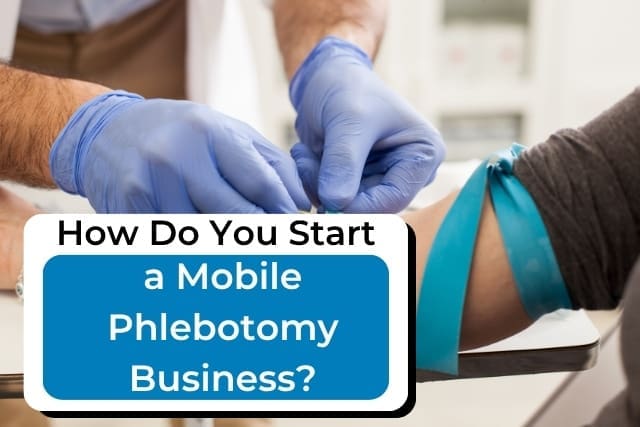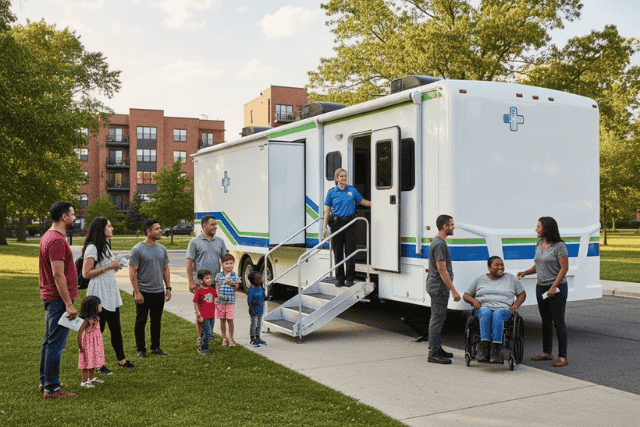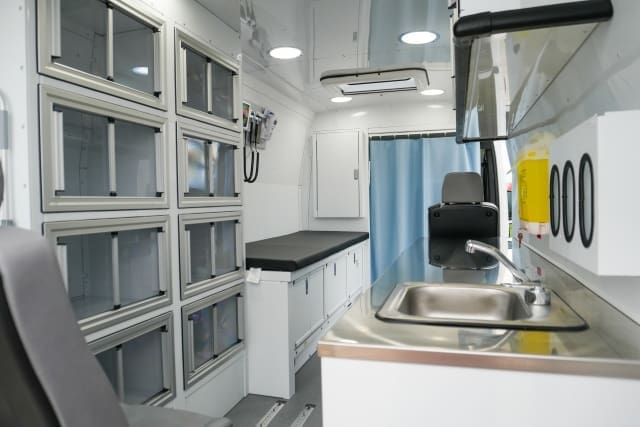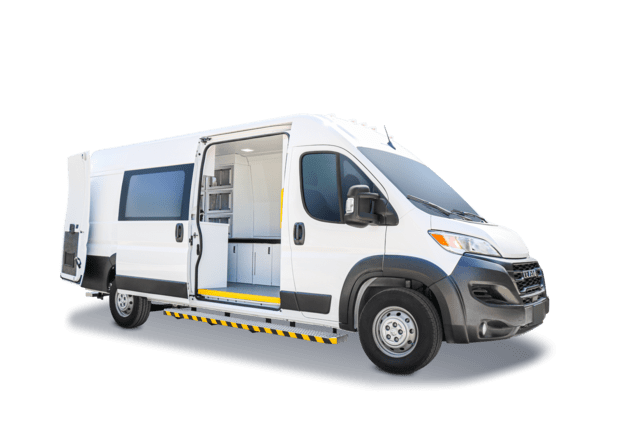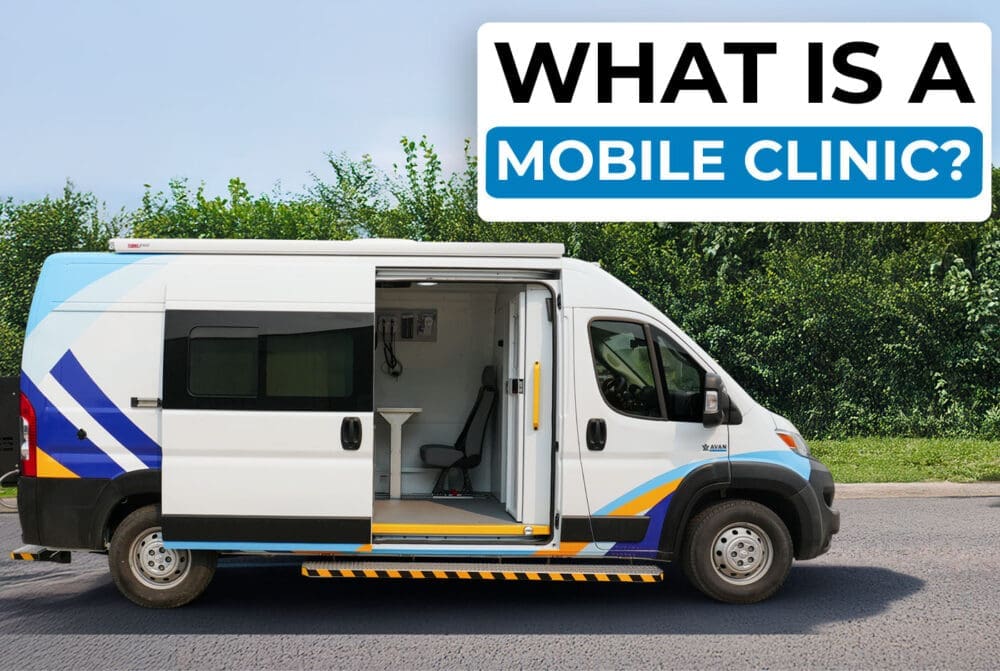Did you know the demand for phlebotomists in the U.S. is expected to grow 8% by 2032? That’s faster than average across all jobs, according to the U.S. Bureau of Labor Statistics. So if you’ve been thinking about launching a mobile phlebotomy business, your timing is spot on.
But let’s be real, it’s exciting and a little nerve-wracking.
You might be thinking:
- Where do I even begin?
- What if I miss something important, like regulations or equipment?
- How do I actually get clients for a mobile phlebotomy business?
There’s a real gap between wanting to serve your community and knowing how to set up a mobile phlebotomy business that actually works. If that gap doesn’t get filled, you risk delays, lost time, and missed opportunities.
For over ten years, our team at AVAN Mobility has helped health teams across the U.S. launch mobile medical units. Our vehicles are designed to support dignity, comfort, and real care on the road. While we build these units ourselves, this article gives you unbiased guidance so you can move forward with confidence.
Here’s a snapshot of what you’ll learn:
- How to start a mobile phlebotomy business
- What goes in your business plan
- What vehicle setup works best
- How to get clients
How to start a mobile phlebotomy business the right way
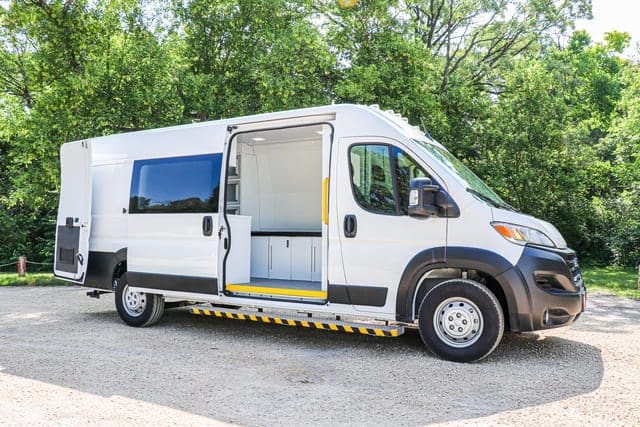
When you’re learning how to start a mobile phlebotomy business, it helps to have a guide that you can use to navigate as you move along. In this section, we’ll walk you through each step and why it’s important.
Step 1: Build a mobile phlebotomy business plan that actually works
If you’re asking yourself, how do I start my own mobile phlebotomy business, the answer starts with a solid business plan. Think of it as your roadmap. Without one, it’s easy to get lost in permits, pricing, and logistics before you even hit the road.
The first step in creating your mobile phlebotomy business plan is understanding why you want to do this and who you’re helping.
Know your “why” before anything else
This part is huge: Your “why” will shape every decision, from how you price services to what kind of vehicle setup you need. It also keeps you grounded when things get stressful (and they will).
Ask yourself:
- Why do I want to start a mobile phlebotomy business?
- Am I solving a problem I’ve seen up close?
- Do I want more freedom in my work life?
- Am I passionate about improving access to care?
Define your audience clearly
Once your “why” is in place, think about who you’re helping. Mobile phlebotomy services work best when they’re focused. The more specific you are, the easier it is to market and build trust.
Examples of audiences include:
- Seniors who can’t travel to labs
- Busy parents who prefer local neighborhood visits
- Rural communities without nearby testing centers
- Employers needing on-site drug testing
- Home health agencies needing reliable lab support
Picking a focused audience helps when it comes to attracting clients for mobile phlebotomy, which we’ll discuss later.
After you’ve narrowed down your target market, you have to figure out the actual services you’ll offer and what to include in your pricing structure.
Pick your services and keep it focused
Many mobile phlebotomy businesses just starting out think they need to provide every test or lab draw under the sun. You don’t. In fact, it’s better to start small and grow as your business and demand grow.
Most mobile phlebotomy services start with:
- Routine blood draws for clinics or homebound patients
- Specimen pickups and delivery to labs
- Pre-employment or workplace drug testing
- Insurance exams
- Specialty test collection for providers
What you choose depends on your audience. If you’re targeting rural home care patients, regular blood draws will be key. If you’re working with local employers, drug screening might be your thing.
Set pricing that’s clear and easy to explain
This is where many mobile phlebotomy companies get stuck. Pricing can feel tricky. But here’s the good news: you don’t need to reinvent the wheel.
A few tips:
- Research local rates: Look at what other mobile phlebotomy providers charge in your state.
- Keep your pricing simple: Flat fees for basic services work well.
- Don’t undercharge: Your time, fuel, and supplies all matter.
- Offer packages: Bundle services for clinics or home care agencies.
Here’s a quick sample table for reference:
| Service | Average price range (USD) |
| Basic blood draw (home visit) | $35–$75 |
| Drug testing (on-site) | $50–$100 |
| Insurance exam collection | $75–$150 |
Pricing is also something clients will ask about early on, especially when you’re figuring out how to get clients for mobile phlebotomy. Having clear pricing makes you look professional and saves back-and-forth emails.
Include your mobile phlebotomy setup in your business plan
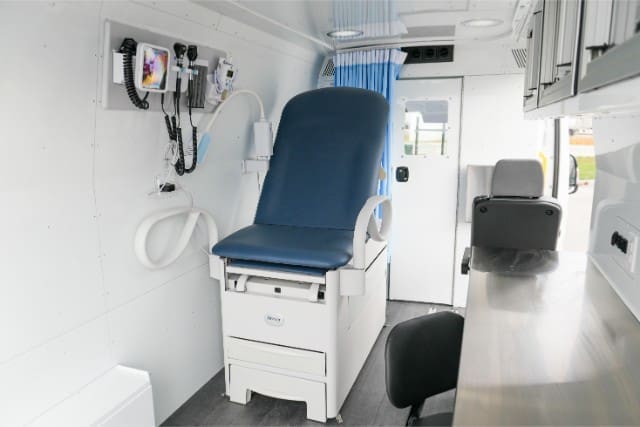
If you’re serious about your mobile phlebotomy business, your vehicle setup needs to be part of the plan from the start. It affects everything from how you deliver care to how clients feel about your service.
You’ll want to think about:
- Interior layout: Is there room for a patient chair, supply storage, and basic sanitation?
- Climate control: Blood samples can’t get too hot or cold.
- Power and lighting: You’ll need reliable lighting and power for small equipment or a mini fridge.
- Privacy and comfort: Patients must feel safe and respected, even in a parking lot.
Some mobile phlebotomy companies choose basic vans, while others go for custom-built medical units with all the extras. It depends on your audience, budget, and how many clients you plan to serve in a day.
Quick example: If you’re operating in Arizona or Texas, heat is a big deal. You’ll need serious AC and insulated storage. In snowy regions like Minnesota, you’ll need winter-ready tires and heated interiors.
It’s also a good time to map out startup costs related to your vehicle, like:
- Monthly lease or purchase payments
- Insurance
- Wrap/branding graphics
- Maintenance and fuel
All of this should go into your mobile phlebotomy business plan so you have a clear view of the investment.
Now that you’ve got your vision, your audience, your services, your pricing, and your mobile setup outlined, you’re ready for the next step, which is about the legal and regulations side of things.
Step 2: Get your legal, licensing, and certifications in order
You’ve got your mobile phlebotomy business plan, your vision, and you know what services you want to offer. Now comes the part that keeps your business compliant and protected, the legal side.
If you’re wondering how do I start my own mobile phlebotomy business in the U.S., this is where things get real. Every state has its own rules, but there are some common steps every mobile phlebotomy business needs to take.
Let’s walk through them.
Choose your business structure
This decides how your business is taxed, what liability you carry, and how you operate. You don’t need to hire a lawyer right away, but you should pick a structure that fits where you’re headed.
Most common options:
- Sole proprietorship: Simple to start, but no legal separation between you and your business
- LLC (Limited Liability Company): Gives you personal liability protection and flexible tax options
- Corporation: More complex and usually better for large teams or long-term scaling
Example: In Georgia, many mobile phlebotomy companies register as LLCs to protect personal assets while keeping paperwork manageable.
Register your business and get an EIN
Once you choose your structure, you’ll need to register your business name with your state.
Then, apply for an EIN (Employer Identification Number) through the IRS website. It’s free and takes about 15 minutes.
You’ll need an EIN to:
- Open a business bank account
- File business taxes
- Hire employees or independent contractors
Look into state-specific healthcare licenses
This part depends on where you’re operating. Some states require specific healthcare facility licenses or lab collection permits, even if you’re a mobile provider.
Examples:
- California: You’ll need to register with the Department of Public Health as a licensed lab or work under one that is
- Florida: Requires mobile healthcare units to meet specific construction standards and get Agency for Health Care Administration (AHCA) approval
- New York: Mobile phlebotomy services must operate under an established clinical lab’s license
Check your state health department or CLIA (Clinical Laboratory Improvement Amendments) site for detailed requirements.
Here’s a helpful resource to get started: CLIA State Agency Contacts
Get certified or hire certified phlebotomists
While you don’t need to be a doctor or nurse to run a mobile phlebotomy business, phlebotomists must be properly trained and certified in most states.
National certifications include:
- NHA (National Healthcareer Association)
- ASCP (American Society for Clinical Pathology)
- NCCT (National Center for Competency Testing)
Tip: Some states, like California, Nevada, and Louisiana, require state-specific phlebotomy certification, too.
Even if you’re already certified, keep up with continuing education requirements to stay sharp and legal.
Don’t forget business insurance
This isn’t legally required in every state, but having insurance is a smart move. It protects you and your clients if anything goes wrong on the road or during a draw.
Types of coverage to consider:
- General liability
- Professional liability
- Commercial auto insurance for your mobile unit
- Workers’ compensation if you have a team
It’s also a confidence booster when you’re figuring out how to get clients for mobile phlebotomy. Clinics and partners will want to know you’re covered.
Double-check HIPAA compliance
Since you’ll be handling patient data, privacy is a big deal. Make sure your forms, file storage, and digital tools are HIPAA compliant.
This includes:
- Consent forms
- Electronic health records (EHRs)
- Communication with labs or providers
Using a HIPAA-compliant software system is a great way to simplify this and avoid fines.
Legal stuff isn’t the most exciting part of starting a mobile phlebotomy business, but it’s what turns your idea into a legitimate operation that people trust.
Step 3: Choose the right vehicle for mobile phlebotomy
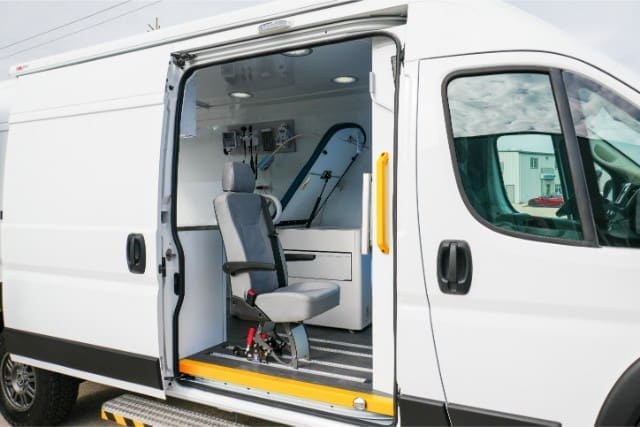
Once your legal boxes are checked, the next big step in launching your mobile phlebotomy business is figuring out what you’ll be driving and working out of.
Your vehicle is more than just wheels. It’s your clinic, your brand, and your patient’s first impression. Whether you’re parked outside a senior’s home or at a corporate health fair, the setup matters.
There’s no one-size-fits-all here. Different vehicle types work for different organizations depending on budget, space, and patient volume.
Let’s break it down.
Comparing vehicles for mobile phlebotomy services
Here’s a quick comparison to help you decide what fits best:
| Vehicle type | Pros | Cons | Best for |
| Van (like a Ram Promaster or Ford Transit) | Compact, easy to drive, lower cost, can be fully customized for phlebotomy | Smaller interior space than RV or trailer | Most common choice for mobile phlebotomy businesses |
| RV | Lots of room, multiple private areas | High upfront cost, expensive to maintain, harder to park | Larger hospital networks or high-volume mobile programs |
| Trailer | Spacious, can be unhitched at location | Requires a towing vehicle, setup takes longer | Regional programs with mobile teams that travel less often |
| SUV | Low cost, easy to drive | No space to perform blood draws comfortably | Good for supply delivery, not suitable as a clinic |
Why vans are the sweet spot
We’ve worked with a lot of organizations launching mobile clinics across the U.S., and vans come up as the top choice again and again.
Here’s why vans work well:
- Cost-effective: More affordable to purchase and outfit than RVs or trailers
- Versatile: Easy to customize for one or two staff with full draw capabilities
- Navigable: Can handle tight city streets and rural backroads
- Professional: Clean, medical-grade interior without looking too bulky or intimidating
At AVAN Mobility, we manufacture medical van setups specifically for mobile health programs, including phlebotomy. While we focus on vans, we always recommend comparing your options based on your specific needs and budget. Some large systems may need RV-sized space. Others might be better off starting small and growing from there.
A quick real-world scenario
Let’s say you’re a nonprofit in North Carolina focusing on blood draws for homebound seniors. A customized van gives you the space, comfort, and privacy your team needs, without blowing your entire grant budget.
Now, imagine trying to do that from an SUV. You’d be juggling supplies from the back seat and asking patients to step outside for privacy. It just doesn’t work long-term.
If you’re asking how do I start my own mobile phlebotomy business without spending a fortune on your first vehicle, a van setup is usually the smartest starting point.
Next, we’ll dive into the gear that goes inside your mobile unit, including everything from refrigeration to the small stuff like sharps containers.
Step 4: Stock your vehicle with the right equipment and supplies
Your van is your base, but it’s the equipment and supplies inside that turn it into a working mobile phlebotomy clinic. If you want patients, partners, and providers to trust you, your setup needs to be clean, organized, and reliable.
You don’t need to overdo it on day one, but there are a few must-haves that every mobile phlebotomy business should start with.
Basic supply checklist for mobile phlebotomy services
Here’s what you’ll want to keep in stock at all times:
- Vacutainer tubes and needle sets
- Tourniquets
- Alcohol prep pads and gauze
- Bandages
- Sharps container (lockable and mounted is best)
- Biohazard disposal bags
- Gloves (latex-free options help avoid reactions)
- Cooler or portable fridge for specimens
- Forms and labels for labs and patients
- Portable centrifuge (if required for your tests)
- Backup power source or inverter (for small equipment)
Interior mobile phlebotomy clinic customization
To perform blood draws safely and comfortably, you’ll need a few key pieces inside your van:
- Patient phlebotomy chair
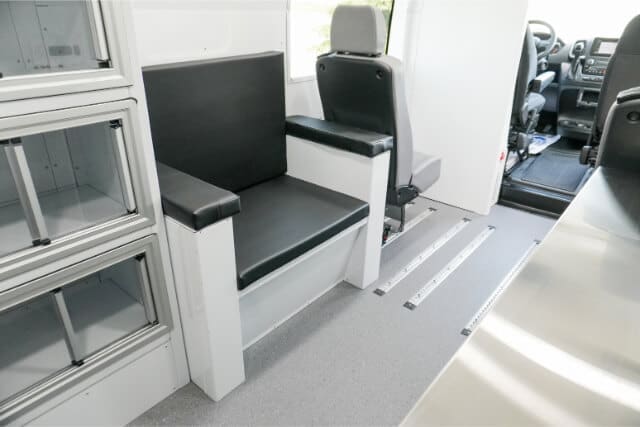
- Work desk with easy-to-clean surface
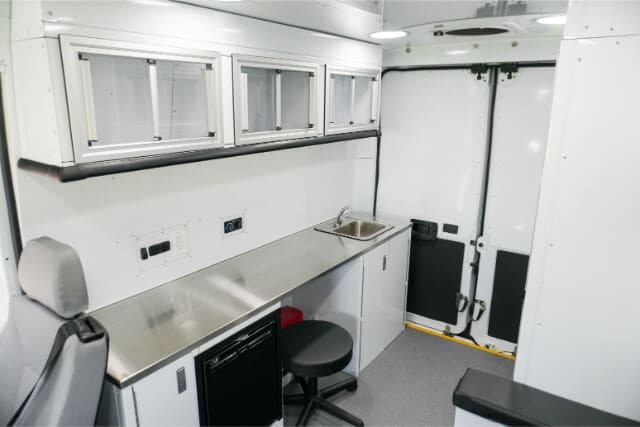
- Lockable supply cabinets
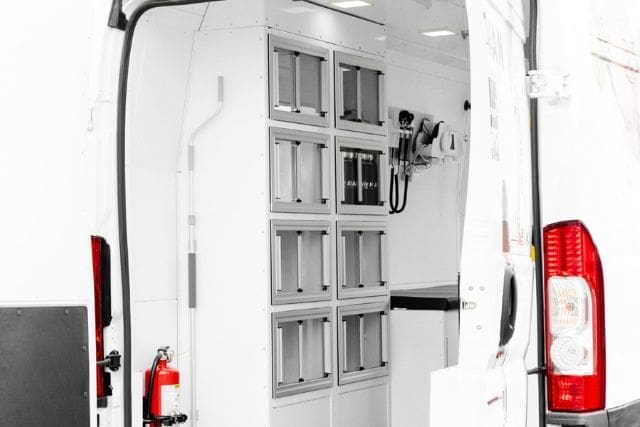
- Hand sanitizer station (and/or sink if required in your state)
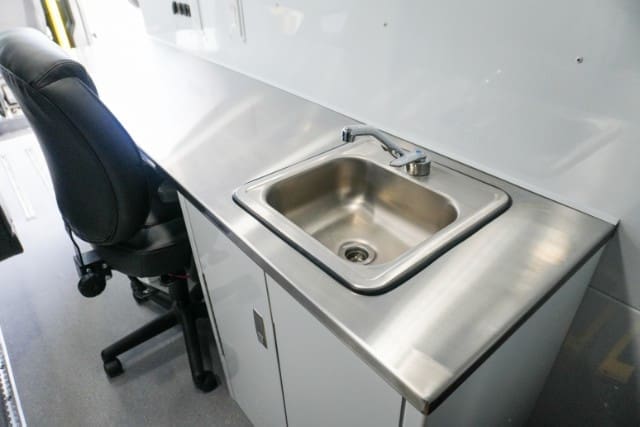
- Interior lighting bright enough for accurate draws
A lot of mobile phlebotomy companies skip out on the comfort part, but that’s a mistake. A nervous patient will remember if your van felt cramped, hot, or messy. A few thoughtful touches go a long way.
Storage and layout tips
Think through your workflow before you start driving to appointments.
- Keep sharps and waste near the draw station for easy disposal
- Separate clean and used supplies to avoid cross-contamination
- Store paperwork near the front seat for easy access during sign-ins
- Use labeled bins or drawers to avoid hunting for items during a visit
And yes, zip ties and Velcro may become your best friend over time.
Customize based on your region and services
Where you work matters. Mobile phlebotomy services in hot climates like Arizona might need extra cooling for samples. In colder states like Wisconsin, you may need heating elements or weather-sealed cabinets.
Offering drug testing or insurance exams? You’ll also need paperwork space and maybe even a privacy curtain for quick screenings.
Once your vehicle is stocked and set up, you’re ready to start seeing patients. But before that, you’ll need to answer a big question: how do I get clients for my mobile phlebotomy business?
Step 5: Find clients and grow your mobile phlebotomy business
You’ve got the business plan. You’re legally set. Your vehicle is stocked and ready. Now comes the big question: how do we get clients for mobile phlebotomy?
This is where a lot of new mobile phlebotomy businesses get stuck. You know you provide a valuable service, but if nobody knows you exist, it won’t matter.
Let’s break down how to get in front of the right people and turn that van into a busy, trusted service.
Start with partnerships in your area
One of the fastest ways to grow is by connecting with organizations that already serve your ideal clients.
Reach out to:
- Home healthcare agencies
- Primary care clinics and doctors’ offices
- Local hospitals or labs
- Long-term care or retirement homes
- Employment agencies needing drug testing
- Insurance companies with mobile exam needs
Quick tip: Walk in with a one-pager explaining your services, pricing, and how you help their workflow, not just a business card.
Example: In Ohio, one startup mobile phlebotomy company built steady income by partnering with a home health agency that needed regular blood draws for over 30 seniors a week.
Use Google Business Profile to show up locally
If someone searches mobile phlebotomy near me, you want to show up. Creating a Google Business Profile is free and helps people in your area find you quickly.
Be sure to:
- Add photos of your mobile unit
- List your service areas
- Include clear contact info
- Ask your first few clients for reviews
Showing up in local searches builds trust.
Build a simple, helpful website
You don’t need a fancy website to start, but you do need a place where people can:
- Learn what mobile phlebotomy services you offer
- Understand your pricing
- See photos of your setup
- Easily book or contact you
Keep it clean, clear, and focused on how you help. And yes, a short FAQ section can cut down on repetitive calls or texts.
Use social media to share real-world stories
People love behind-the-scenes stories. Use platforms like Facebook and Instagram to:
- Show your van on the road
- Talk about your services
- Share client success stories (with permission)
- Highlight your mission and “why”
This humanizes your business and builds local loyalty. It’s also free marketing.
Join local business and healthcare groups
From Chamber of Commerce events to health fairs, getting out in your community is huge. You never know who you’ll meet at a networking event or a public clinic.
Bring:
- A clean branded setup
- Handouts or flyers
- A short pitch that explains your service clearly
The more people hear about you, the more likely they are to remember you when they need a mobile phlebotomy company.
Keep relationships warm
Once you land a few regular clients, treat them like gold. A little follow-up and great service can turn one partnership into referrals and long-term contracts.
Simple ways to stay top of mind:
- Send a quick thank-you after visits
- Offer seasonal check-ins or service reminders
- Ask for feedback and actually use it
Clients who trust you will tell others.
So, how do you get clients for mobile phlebotomy? You build relationships, show up consistently, and make it easy to work with you. It’s not about flashy marketing, it’s about solving real problems for real people.
Ready to start your mobile phlebotomy business? Let’s take the next step
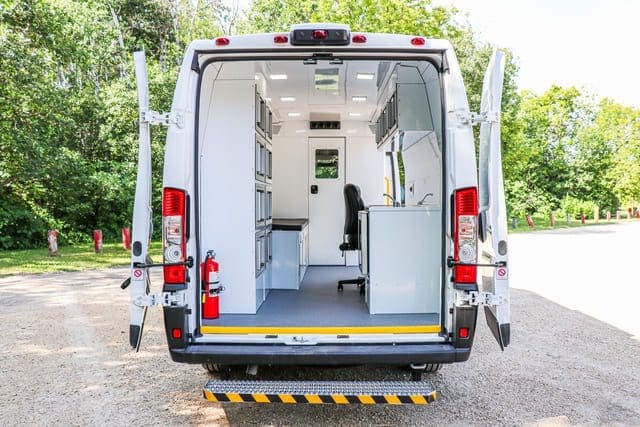
You came to this article wondering how to start a mobile phlebotomy business or maybe even asking yourself where to begin so you can avoid costly mistakes. You might’ve felt overwhelmed by licensing, unsure about what type of vehicle to choose, or how to find your first clients.
Now you’ve got a roadmap. Here’s what you learned:
- How to build a mobile phlebotomy business plan that works for your goals
- What legal steps and certifications you need to operate in the U.S.
- Which vehicles fit best for mobile phlebotomy services (and why vans make sense)
- What equipment and supplies you need to get started
- How to get clients for your mobile phlebotomy business using real-world outreach tactics
At AVAN Mobility, we manufacture solutions for organizations like yours that care about access to healthcare. From coast to coast, we’ve supported new mobile health programs with practical guidance, custom vehicle setups, and a team that listens before anything else. We’ve worked with nonprofits, healthcare systems, and independent providers who, like you, want to serve people better. It’s about helping you launch something that really matters.
If you have questions or want help figuring out your next move, click the button below to talk to a mobility expert. We’re here to help.
If you’re not ready to talk to a mobility expert yet, no problem. These articles can help guide your next steps and dig deeper into what comes after your business planning phase:
- Buying a mobile medical van: Your process with AVAN Mobility: A clear look at how the purchasing journey works from first call to final delivery
- Mobile medical van customization: What is it all about?: Learn what customization options are available and how to build a unit around your phlebotomy needs
